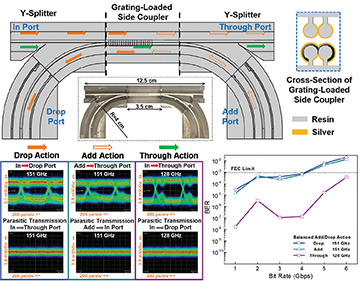 Two-wire waveguide-based interferometric ADM circuit and its channel allocation functionalities. [Enlarge figure]
Two-wire waveguide-based interferometric ADM circuit and its channel allocation functionalities. [Enlarge figure]
Terahertz communication is poised to become a key enabler of next-generation communication systems. Developing optical systems in which THz signals can be efficiently manipulated, however, is an ongoing challenge. Compared with cumbersome discrete free-space optics, THz waveguides can provide a universal platform integrating intriguing functionalities, thereby facilitating miniaturization and mass-production of cost-effective THz communication systems.
In 2020, we proposed THz plasmonic circuits using two-wire waveguides, in a design enabled by additive manufacturing.1 This year, we demonstrated a THz add-drop multiplexer (ADM)—an indispensable device for frequency-division multiplexing (FDM)—based on this platform.2
The quasi-two-wire waveguide involves two metallized dielectric cylinders suspended in air and encapsulated within a protective enclosure.1 It features low transmission and bending losses, low group velocity dispersion, and broadband operation compared with other reported THz waveguides. Its unique modular nature and robust structure allow trivial assembly and sectional reconfiguration of plasmonic circuits without painstaking alignment.
As the unregulated lower-THz band accommodates multiple high-bandwidth channels, beyond current state-of-art single-channel THz links that support data transmission up to
100 Gbps, THz FDM promises to open significant new data-throughput capacity in THz communication networks. The ADM we demonstrated this year could help enable such FDM.2 In each ADM, the grating-loaded side coupler spatially separates add and drop channels designed for the THz wavelengths falling within the grating stopband, while letting other wavelengths within the coupler bandwidth pass through. Channel Add and Drop actions can be contiguously efficient within the entire grating stopband for broadband THz signal, and can also be selectively efficient at certain spectral positions for narrowband channels by adjusting the relative position of gratings on the side coupler.
Channel-allocation functionalities of ADMs were experimentally demonstrated using a photonics-based THz communication system employing amplitude-shift-keying modulation. THz transmitters with higher power and more efficient beam steering should be able to achieve a clear channel of high-data-rate THz signals. Additionally, channel allocation of multiple THz signals at different carrier frequencies should be readily achievable using tandem ADM circuits.
We believe this two-wire plasmonic circuit—the advantages of which include ease in manufacturing and packaging, modularity, tunability and 3D integration—can compete with emerging THz monolithic integrated circuits for applications in THz communications, especially for networks requiring customizable and reconfigurable configuration. This photonic circuit should also have a strong impact on THz optics, as it shows a pathway toward democratizing the development of versatile THz optical systems through an easily accessible, universal platform.
Researchers
Yang Cao, Kathirvel Nallappan, Hichem Guerboukha, Guofu Xu and Maksim Skorobogatiy, École Polytechnique de Montréal, Montréal, QC, Canada
References
1. Y. Cao et al. Optica 7, 9 (2020).
2. Y. Cao et al. Nat. Commun. 13, 4090 (2022).
